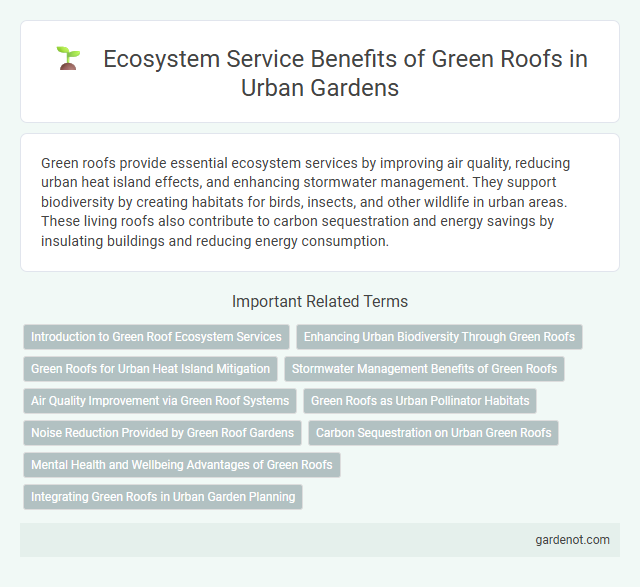Green roofs provide essential ecosystem services by improving air quality, reducing urban heat island effects, and enhancing stormwater management. They support biodiversity by creating habitats for birds, insects, and other wildlife in urban areas. These living roofs also contribute to carbon sequestration and energy savings by insulating buildings and reducing energy consumption.
Introduction to Green Roof Ecosystem Services
Green roofs provide essential ecosystem services by enhancing urban biodiversity, improving air quality, and managing stormwater runoff. These living systems mitigate heat island effects through temperature regulation and support pollinator habitats in densely built environments. Integrating green roofs into city infrastructure promotes sustainable urban development and resilience against climate change impacts.
Enhancing Urban Biodiversity Through Green Roofs
Green roofs provide essential habitat for diverse urban wildlife, supporting pollinators like bees and butterflies while promoting native plant species. These living roofs enhance ecological connectivity by creating green corridors across urban landscapes, facilitating species movement and genetic exchange. Integrating green roofs into city planning significantly boosts urban biodiversity, contributing to resilient and sustainable ecosystems.
Green Roofs for Urban Heat Island Mitigation
Green roofs provide critical ecosystem services by reducing urban heat island effects through increased vegetation cover and evapotranspiration, which lower ambient temperatures in densely built environments. The enhanced thermal regulation improves air quality and reduces energy consumption for cooling in urban buildings. Studies show that green roofs can decrease surface temperatures by up to 40degC, significantly mitigating heat stress in cities.
Stormwater Management Benefits of Green Roofs
Green roofs significantly enhance stormwater management by absorbing and retaining rainfall, reducing runoff volume and peak flow rates. Their layered substrates and vegetation facilitate water infiltration, decreasing the burden on urban drainage systems and mitigating flood risks. By filtering pollutants and stabilizing water flow, green roofs contribute to improved water quality and ecosystem health in urban environments.
Air Quality Improvement via Green Roof Systems
Green roof systems significantly enhance urban air quality by capturing airborne pollutants such as particulate matter, nitrogen oxides, and sulfur dioxide through their extensive vegetation and substrate layers. These green roofs act as natural air filters, reducing smog formation and mitigating heat island effects by lowering surface temperatures. Studies show that cities implementing widespread green roof installations experience improved public health outcomes due to decreased exposure to harmful air contaminants.
Green Roofs as Urban Pollinator Habitats
Green roofs significantly enhance urban biodiversity by providing critical habitats for pollinators such as bees, butterflies, and other beneficial insects. These elevated green spaces contribute to ecosystem services by supporting pollination processes essential for urban plant reproduction and food production. Integrating diverse native flowering plants on green roofs maximizes habitat quality and promotes pollinator population resilience in densely built environments.
Noise Reduction Provided by Green Roof Gardens
Green roof gardens significantly reduce urban noise pollution through their dense vegetation and substrate layers that absorb, deflect, and dampen sound waves. By mitigating ambient noise, these green roofs improve the acoustic comfort of surrounding buildings and outdoor spaces, enhancing overall urban livability. Studies show that green roofs with thicker soil and diverse plant species offer greater noise attenuation, contributing to healthier, quieter environments.
Carbon Sequestration on Urban Green Roofs
Urban green roofs significantly enhance carbon sequestration by capturing atmospheric CO2 through their extensive vegetation layers and substrate. These green roofs contribute to reducing urban heat island effects while promoting biodiversity and improving air quality. Studies indicate that well-designed green roofs can sequester up to 30% more carbon annually compared to conventional roofing systems.
Mental Health and Wellbeing Advantages of Green Roofs
Green roofs provide significant mental health and wellbeing advantages by creating natural, calming environments in urban settings, which can reduce stress and enhance mood. Exposure to green spaces on rooftops has been linked to improved cognitive function, increased relaxation, and decreased symptoms of anxiety and depression. These ecosystem service roofs contribute to overall psychological resilience by offering accessible, restorative spaces that promote social interaction and connection with nature.
Integrating Green Roofs in Urban Garden Planning
Integrating green roofs into urban garden planning enhances ecosystem services by improving air quality, regulating urban temperature, and supporting biodiversity in dense city environments. Green roofs provide critical habitats for pollinators and birds while reducing stormwater runoff through natural absorption and filtration processes. Strategic placement of vegetation on rooftops complements ground-level gardens, creating interconnected urban green spaces that promote ecological resilience.
Ecosystem service roof Infographic

 gardenot.com
gardenot.com